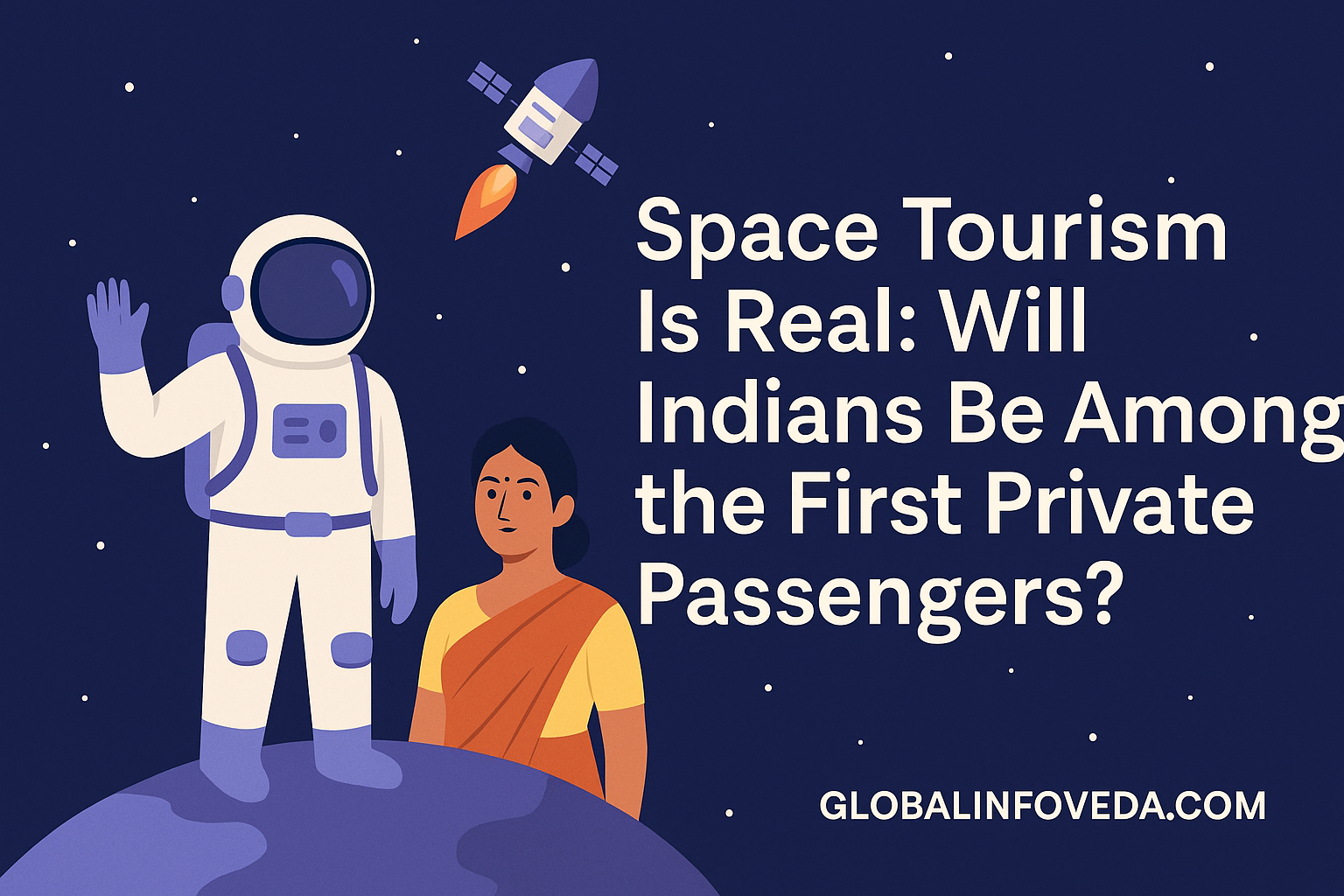Space Tourism Is Real
🚀 Introduction: From Sci-Fi to Boarding Pass
Space tourism is no longer science fiction—it’s rapidly becoming a real, luxurious (and eventually commercial) experience. As global players like SpaceX, Blue Origin, Virgin Galactic, and Axiom Space expand operations, 2025 marks the tipping point where outer space becomes a travel destination for the elite.
But can Indians join this next frontier? With India’s growing space ecosystem, billionaire backers, ambitious youth, and a rising middle class—the countdown to Indian private passengers has begun.
The global space economy is projected to hit $1 trillion by 2040, with tourism estimated to contribute 8–10% of that. For India, entering this market isn’t just about prestige—it’s about economic opportunity, strategic influence, and futuristic innovation.
🌌 The Current Landscape of Space Tourism
✅ Types of Space Travel Experiences in 2025:
| Type | Description | Providers |
|---|---|---|
| Suborbital Flights | 10–15 minute flights beyond Kármán line; zero gravity and Earth views | Blue Origin, Virgin Galactic |
| Orbital Missions | Multi-day missions circling Earth; often in Crew Dragon capsules | SpaceX, Axiom Space |
| Lunar Flybys | Circumnavigation of the Moon with deep-space views | SpaceX (planned via Starship) |
| Space Station Stays | Tourism to commercial stations, including labs and zero-gravity suites | Axiom Space, future Bigelow (TBD) |
🌍 Milestones in 2025:
- SpaceX’s Polaris Dawn to conduct the first-ever private spacewalk.
- Axiom’s Ax-4 launches with Asia and Africa’s first private space travelers.
- Virgin Galactic’s VSS Unity schedules 24 flights annually, expanding consumer access.
- Blue Origin launches its first celebrity-chartered mission, signaling broader cultural interest.
- Over 100 tourists globally have already been to space.
🇮🇳 India in the Space Race: Progress & Ambitions
🛰️ Government Initiatives:
- Gaganyaan (ISRO): First Indian human spaceflight mission, now in final training phase.
- IN-SPACe: India’s space promotion body, supporting private-sector participation.
- Indian National Space Policy 2023: Legalizes commercial space activities and promotes FDI in space tech.
- Department of Space (DoS) is drafting a roadmap for space commercialization zones in cities like Bengaluru, Hyderabad, and Ahmedabad.
🚀 Indian Private Startups:
- Skyroot Aerospace: Launched Vikram-S, India’s first privately built rocket (2022).
- Agnikul Cosmos: Building 3D-printed, customizable launch vehicles for nano-satellite deployment.
- Pixxel: Launching India’s first private constellation of Earth imaging satellites.
- Bellatrix Aerospace: Developing non-toxic propulsion systems for deep-space missions.
India’s private space sector has attracted over ₹1,000 crore in venture funding since 2021, and is growing at 50% YoY.
🧑🚀 Indians Who’ve Already Made History
- Rakesh Sharma (1984): The first Indian in space. Famous quote: “Saare Jahan Se Achha.”
- Gopi Thotakura (2024): First Indian space tourist via Blue Origin’s NS-25.
- Sunita Williams & Raja Chari: Indian-origin astronauts at NASA—paving the way in global space diplomacy.
In the pipeline: 5 Indian nationals shortlisted by private consortia for upcoming suborbital flights in 2026–27.
💸 Can Indians Afford Space Travel?
| Company | Price/Seat | Details |
|---|---|---|
| Blue Origin | $250,000 (~₹2 crore) | Suborbital, 10-min flight |
| Virgin Galactic | $450,000 (~₹3.6 crore) | Edge-of-space glide with 4–5 min weightless |
| SpaceX Crew Dragon | $55 million+ (~₹450 crore) | Orbital, multi-day journey |
| Axiom Missions | $60 million+ (~₹500 crore) | Up to ISS/station for 7–10 days |
🔓 Financing & Access Models Emerging in India:
- Fintech-led SIP plans for space savings (proposed by startups in Bengaluru).
- Corporate CSR sponsorships for space access linked to sustainability or innovation causes.
- Reality-TV and talent competitions offering “space tickets” as grand prizes.
- Student exchange with ESA, NASA, and Japanese Space Agency (JAXA) under new MoUs.
🛰️ India’s Roadmap to Private Passenger Travel
- 2025–2026: Gaganyaan launches → proves life-support and re-entry systems.
- 2027: ISRO partners with private firms for low-orbit experimental tourism capsules.
- 2028: First Indian passenger on an international suborbital tourism flight.
- 2029: Launch of India’s first commercial spaceflight training facility in Bengaluru.
- 2030: Predicted launch of Indian suborbital passenger program (cost target: ₹1–1.5 crore/seat).
🧑🔬 Who Are India’s Likely First Passengers?
- Bollywood superstars: Interest already expressed by multiple high-profile names.
- Unicorn founders & startup investors: Leading Indian crypto investors and tech CEOs in talks.
- Young STEM champions: Olympiad toppers or ISRO-linked student researchers.
- Women in Space Science: Gender-inclusive spaceflight programs are being designed.
🛰️ Strategic Benefits for India
- Global Leadership: Soft power boost through visible presence in global missions.
- STEM & Aerospace Employment: Potential to generate 10,000+ jobs by 2030 in ancillary industries.
- Boost to Innovation: Cross-pollination between space, defense, AI, and robotics.
- International Brand Equity: India will position itself as a high-tech power—not just a service hub.
🤯 Final Insight: A Ticket to the Stars
2025 is not just the year of space tourism’s takeoff—it’s also India’s moment to rise as a serious participant in the commercial space age.
While a ₹2–3 crore ticket still places space out of reach for the average Indian, the trajectory is clear: with reusable rockets, private launches, and smart policymaking, the barriers are falling.
If India’s public-private ecosystem continues its momentum, boarding a space capsule from Sriharikota or a desert base in Gujarat by 2030 isn’t just possible—it’s probable.
Follow India’s space frontier at GlobalInfoVeda.com
